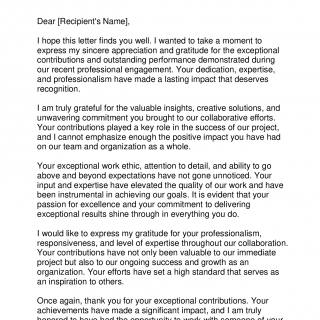Professional Thank You Letter
The Professional Thank You Letter is a communication sent in a business context to express appreciation for partnerships, collaborations, or outstanding performance during a professional engagement. The main purpose of this letter is to acknowledge and show gratitude for the individual or organization's contributions, maintain a positive business relationship, and potentially strengthen future collaborations.
The letter typically consists of the following parts:
- Salutation: Begin the letter with a professional greeting, addressing the recipient by name or using a general salutation like "Dear [Recipient's Name]" or "To Whom It May Concern."
- Introduction: In the opening paragraph, express your gratitude and mention the reason for writing the letter. State that you want to take a moment to express your sincere appreciation for the individual or organization's contributions, partnership, or outstanding performance.
- Specific Contributions: In the body of the letter, provide specific examples or details regarding the individual or organization's significant contributions or achievements. Highlight their professionalism, expertise, efficiency, dedication, or any other noteworthy qualities that made a positive impact on the project or engagement.
- Impact and Gratitude: Discuss the impact their contributions have had on your organization, project, or professional growth. Express your gratitude for their exceptional work, support, collaboration, or partnership. Emphasize the value they have brought to the table and how their contributions have furthered the collective goals or success.
- Closing: Conclude the letter with a closing sentiment, such as "Once again, thank you for your exceptional contributions" or "Your achievements have made a significant impact." Sign off with a professional closing, such as "Sincerely" or "Best regards," followed by your name, job title/position, and contact information.
Sample of Professional Thank You Letter
Dear [Recipient's Name],
I hope this letter finds you well. I wanted to take a moment to express my sincere appreciation and gratitude for the exceptional contributions and outstanding performance demonstrated during our recent professional engagement. Your dedication, expertise, and professionalism have made a lasting impact that deserves recognition.
I am truly grateful for the valuable insights, creative solutions, and unwavering commitment you brought to our collaborative efforts. Your contributions played a key role in the success of our project, and I cannot emphasize enough the positive impact you have had on our team and organization as a whole.
Your exceptional work ethic, attention to detail, and ability to go above and beyond expectations have not gone unnoticed. Your input and expertise have elevated the quality of our work and have been instrumental in achieving our goals. It is evident that your passion for excellence and your commitment to delivering exceptional results shine through in everything you do.
I would like to express my gratitude for your professionalism, responsiveness, and level of expertise throughout our collaboration. Your contributions have not only been valuable to our immediate project but also to our ongoing success and growth as an organization. Your efforts have set a high standard that serves as an inspiration to others.
Once again, thank you for your exceptional contributions. Your achievements have made a significant impact, and I am truly honored to have had the opportunity to work with someone of your caliber. Should there be any further opportunities for collaboration in the future, I would welcome the chance to partner with you again.
Please know that your exceptional performance has not gone unnoticed, and your reputation as a consummate professional is well-deserved. Should you require any support or assistance in your future endeavors, please do not hesitate to reach out.
Wishing you continued success and fulfillment in all your future endeavors.
Sincerely,
[Your Name]
[Your Position/Job Title]
[Organization]
[Contact Information]
When writing the letter, it is important to maintain a professional and appreciative tone. Personalize the letter by mentioning specific instances or examples of outstanding performance or contributions. Proofread the letter for any grammatical or typographical errors before sending it.
No additional documents are typically required or attached to the Professional Thank You Letter. However, if there are any relevant project reports, performance evaluations, or testimonials that showcase the recipient’s contributions, you can mention them in the letter and offer to provide them upon request.
Strengths of the Professional Thank You Letter include fostering positive business relationships, acknowledging exceptional performance, and potentially paving the way for future collaborations. It demonstrates professionalism, gratitude, and the ability to maintain relationships, which can be beneficial for networking or future business opportunities.
One potential weakness or challenge is ensuring that the letter conveys genuine appreciation and avoids sounding overly generic or insincere. Personalization and specificity are important to convey authentic gratitude.
Related and alternative forms of expressing appreciation in a professional context include sending a small gift or token of appreciation, organizing a formal thank-you event or gathering, or providing positive feedback through professional networking platforms. The choice of form depends on the nature of the professional engagement and the desired level of appreciation.
The Professional Thank You Letter positively impacts the future of the participants by fostering positive business relationships, potential referrals, and future collaborations. It strengthens professional connections and leaves a lasting impression that can contribute to future business opportunities.
The letter is typically submitted via email or as a printed letter, depending on the recipient's preferences and the preferred mode of communication. If sending via email, ensure it is addressed directly to the recipient or the appropriate department. If sending a printed letter, use the recipient's business address. Keep a copy of the letter for your own records, and the recipient may retain it for testimonials, reputation-building, or business documentation.

